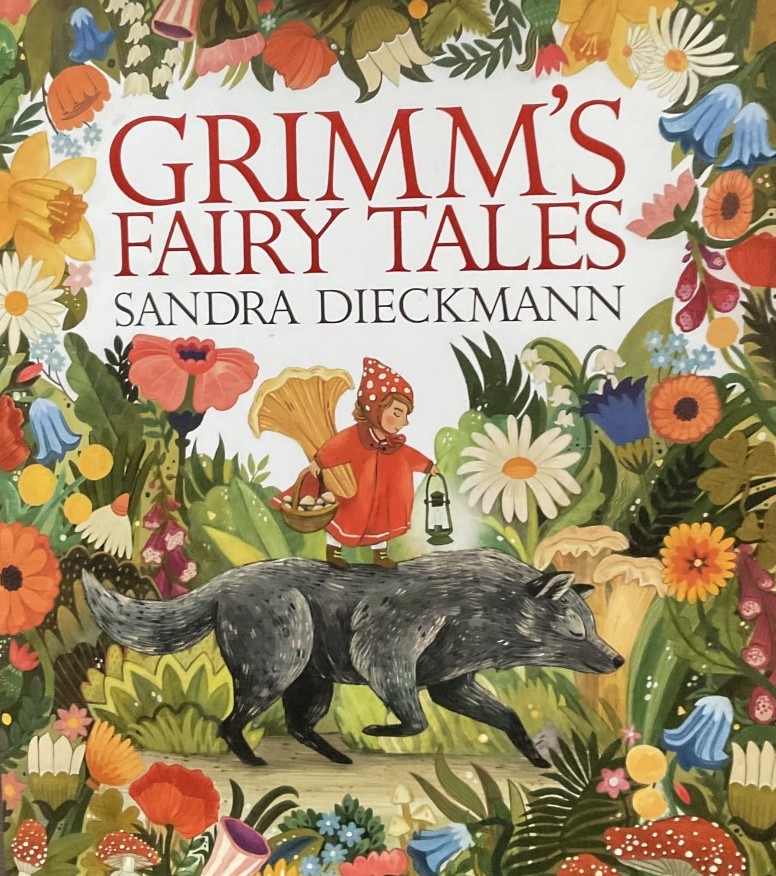Inspiring Young Readers
 posted on 07 Nov 2024
posted on 07 Nov 2024
Grimm’s Fairy Tales by Sandra Dieckmann
It is always a creative challenge for authors and illustrators to revisit classic stories that have been around for generations of readers. In the case of Fairy Tales by the Brothers Grimm, this must be particularly difficult. Who could not be influenced by the many book versions experienced when a child, never mind film and other media interpretations?
I have a huge personal collection of these memorable tales that include several anthologies of the more well- known stories, plus many that have been illustrated by renowned illustrators ranging from Arthur Rackham to contemporary artists such as Michael Foreman. I was drawn to this one by the richly coloured front cover showing a girl wearing a red coat standing on the back of a huge, docile looking grey wolf. The pair are framed by a gorgeous border of flowers and foliage, as if we are being treated to a secret view of this woodland adventure.
I very much enjoyed all of the twenty stories, but will focus on just three examples to give a flavour of the range.
Sleeping Beauty
The scene is concisely set for this familiar tale with a swan granting the wish of a little girl being born to a childless Queen as she bathes in the water,. This is followed by the celebratory feast attended by twelve fairies who live in the realm to welcome the new child into the world. Here the thirteenth fairy issues her dreadful curse, because she was not invited.
Children hearing this story for the first time may want to know more about the dreaded spindle that is predicated to prick the finger of the princess when she is sixteen. Luckily, the twelfth fairy is able to make a small amendment to the curse by explaining that she will merely fall asleep for one hundred years instead of dying.
Surely all children will be reassured that her loving parents keep her protected and safe as she grows up to make sure that she never has the predicted accident. My wise six-year-old grandson asked why they then made the somewhat reckless decision to let her wander about without protection from the day she turned sixteen! As predicted, she meets her fate when she discovers and climbs the narrow staircase of small, dark tower and so falls into a hundred-year-long sleep. I always shiver at this point in the story as the spell sweeps up everything around her:
‘Every man, woman and child in the castle closed their eyes in sleep. Even the wind stopped blowing as an eerie silence befell the castle.’
I was intrigued with Dieckmann's depiction of a princess as a modern looking barefoot girl with abundant auburn curls which is one example of the many generous double page spreads throughout the volume. Other than that, this interpretation of Sleeping Beauty follows the conventional shape with a ‘happy ever after’ ending.
The Star Talers
I liked the inclusion of some more unfamiliar tales such as this short one that tells a story of a poor, orphaned girl who has to fare for herself ‘into an unknown future.’ Despite her dreadful misfortune, she has a kind heart and selflessly shares her bread with a poor old beggar and her clothes with three freezing children. As she stands alone in the dark forest, stars fall from the night sky and wonderful magic occurs as they change into gold coins:
‘She gathered the coins and was rich for evermore.’
Little Red Cap
There are so many versions of this tale, usually known as ‘Little Red Riding Hood’, that warn against not listening to parents and being wary of strangers in the dangerous forest. I am always curious to see how the wolf is dealt with at the end. Will he be hacked open and left for dead by the rescuer or will he be treated more sympathetically? In this version he is given another chance to redeem his wicked ways:
‘Back in the day’, the ranger warned the wolf, ‘they would have sewn heavy rocks into your stomach so you fell over dead right her, but I have a better plan. I know a place that big bad wolves go to and that’s where I’m going to take you.’
I assumed that this would be another forest but the ending leaves the reader to think about this because Little Red Cap warns him that he needs to reflect on his crimes and so he feels suitably afraid of his possible destination. My six-year-old grandson explained that he would probably be off to some kind of wolf prison – we hoped that it wouldn’t be too harsh. I can see how teachers might use this as an interesting discussion point,
Sandra Dieckmann was apparently inspired to create this enchanting anthology by her own childhood in Northern Germany where she loved reading European folklore. She dedicates it especially to children who may not be free, in order to escape ‘even for just a brief moment, from the reality of your life’. That is an important function of fiction, along with helping readers to make some sense of reality.
I recommend this beautifully illustrated collection published by Walker Books. You will be able to get a copy form your local independent bookshop and if they don’t have copies on their shelves, they will be happy to order it for you.
Karen Argent
November 2024


